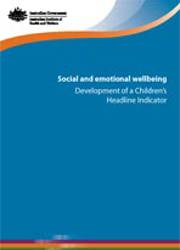Summary
The Children’s Headline Indicators are a set of measures designed to focus policy attention and to help guide and evaluate policy development on key issues for children’s health, development and wellbeing in 19 priority areas. They were endorsed by health, community and disability services ministers and education systems officials in 2006. Headline Indicators were defined for 16 of these priority areas. However, more work was needed on the remaining three—family social network, social and emotional wellbeing and shelter—to conceptualise and identify the most important aspects of these areas for children’s health, development and wellbeing.
This information paper outlines the process of developing a Headline Indicator for the social and emotional wellbeing priority area.
Identifying and defining a Headline Indicator
Developing a Headline Indicator for social and emotional wellbeing involved:
- conceptualising social and emotional wellbeing—defining its scope, theoretical basis, and main elements
- reviewing the literature on social and emotional wellbeing and children’s outcomes
- identifying possible indicators by reviewing indicator frameworks and reports
- consulting key experts and stakeholders.
Based on this research and consultation, the Strengths and Difficulties Questionnaire (SDQ) was strongly supported as the most appropriate tool for measuring social and emotional wellbeing in children. This instrument has been extensively validated, and is used widely as a population measure, both internationally and in Australia. Modified versions have also been developed for Indigenous children. It is recommended that a Children’s Headline Indicator for social and emotional wellbeing, based on the SDQ, be defined as the proportion of children scoring ‘of concern’ on the Strengths and Difficulties Questionnaire.
Next steps
There is currently no national data source in Australia suitable for reporting on the recommended Headline Indicator for social and emotional wellbeing. Work is needed to determine the most appropriate data collection method and vehicle for this Headline Indicator. Consideration should be given to a large-scale national survey, that:
- uses children as the counting unit
- captures demographic information
- allows disaggregation by state and territory for subpopulations of children (for example, Aboriginal and Torres Strait Islander children).
Alternatively, the SDQ could be incorporated in a standardised manner into state/territory-based population health surveys; however, survey methods would need to be considered to ensure comparable data.
Summary
- Identifying and defining a Headline Indicator
- Next steps
-
Introduction
- Background
- Process of identifying a Headline Indicator
- Structure of this information paper
-
Policy context
- COAG reform agenda
- Family Support Program
- Other Commonwealth initiatives
-
Definition and conceptualisation
- Defining social and emotional wellbeing
- Conceptualising social and emotional wellbeing
-
Social and emotional wellbeing and children’s outcomes
- Individual internal and relational characteristics
- Environments in which children develop
-
Potential indicators for social and emotional wellbeing
- From concepts to indicators
- Selecting a single indicator
- Potential indicators and measurement tools
-
Identifying and defining a Headline Indicator
- Self-report data items
- ACER Social and Emotional Wellbeing Survey
- Strengths and Difficulties Questionnaire
- Discussion and recommendations
- Data collection issues
Appendixes
- Appendix A: Process to identify a Headline Indicator
- Appendix B: Headline Indicator Data Development Expert Working Group
- Appendix C: Social and Emotional Wellbeing Workshop participants
- Appendix D: Headline Indicators for children’s health, development and wellbeing
- Appendix E: Additional information on selected surveys and screening tools
End matter: Acknowledgments; Abbreviations; References; List of tables; List of figures



